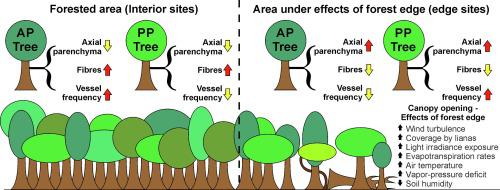当前位置:
X-MOL 学术
›
Forest Ecol. Manag.
›
论文详情
Our official English website, www.x-mol.net, welcomes your
feedback! (Note: you will need to create a separate account there.)
Intraspecific variation in functional wood anatomy of tropical trees caused by effects of forest edge
Forest Ecology and Management ( IF 3.7 ) Pub Date : 2020-10-01 , DOI: 10.1016/j.foreco.2020.118305 Warlen Silva da Costa , Maura Da Cunha , Pablo José F. Pena Rodrigues , Mariana de Andrade Iguatemy , Fernando Valladares , Claudia Franca Barros
Forest Ecology and Management ( IF 3.7 ) Pub Date : 2020-10-01 , DOI: 10.1016/j.foreco.2020.118305 Warlen Silva da Costa , Maura Da Cunha , Pablo José F. Pena Rodrigues , Mariana de Andrade Iguatemy , Fernando Valladares , Claudia Franca Barros

|
Abstract Forest edge effects promote striking microclimatic shifts that result in greater light exposure, increased air temperature and evapotranspiration rates, and reduced soil moisture can alter stem hydraulic conductivity. These environmental conditions greatly increase the risk of emboli in xylem, which can disrupt or even cease water transport. We investigated tropical tree species in contrasting sites to understand the influence that edge effects have on wood functional anatomy. We compared wood anatomical traits between trees of forest edge and forest interior sites. The species exhibited two types of xylem arrangements based on the distribution of parenchyma cells: Pseudopiptadenia inaequalis and Copaifera lucens, with paratracheal axial parenchyma (PP), and Eugenia excelsa and Erythroxylum cuspidifolium, with predominant apotracheal axial parenchyma (AP). Tree species with PP xylem possessed shorter and wider vessel elements and lower ray and vessel frequencies, while species with AP xylem possessed longer and narrower vessel elements and higher ray and vessel frequencies. Regardless of the axial parenchyma arrangement, all four species had a greater percentage of axial parenchyma at the edge sites. The different xylem arrangements showed distinct responses to the edge effect in vessel frequency. The tropical tree species studied here shift to a greater abundance of axial parenchyma when subjected to effects of forest edge, probably to ensure safe water transport. This behavior, in the face of environmental stresses, is a plastic response, and likely due to functional versatility of parenchyma cells. The patterns of vessel frequency for PP and AP suggest that these xylem arrangements can be considered functional groups since the species in each group share similar traits and have similar strategies for conducting and maintaining water flow.
中文翻译:

森林边缘效应引起热带树木功能木材解剖学的种内变异
摘要 森林边缘效应促进了显着的小气候变化,导致更多的光照、气温升高和蒸散率增加,以及土壤湿度降低会改变茎的水力传导率。这些环境条件大大增加了木质部栓塞的风险,这会破坏甚至停止水的运输。我们调查了对比地点的热带树种,以了解边缘效应对木材功能解剖结构的影响。我们比较了森林边缘和森林内部地点的树木之间的木材解剖特征。该物种根据薄壁组织细胞的分布表现出两种类型的木质部排列:Pseudopiptadenia inaequalis 和 Copaifera lucens,具有气管旁轴向薄壁组织 (PP),以及 Eugenia excelsa 和 Erythroxylum cuspidifolium,以气管轴向实质(AP)为主。具有PP木质部的树种具有更短和更宽的脉管元素和更低的射线和脉管频率,而具有AP木质部的树种具有更长更窄的脉管元素和更高的射线和脉管频率。无论轴向薄壁组织如何排列,所有四个物种在边缘部位都有更大百分比的轴向薄壁组织。不同的木质部排列对血管频率的边缘效应显示出不同的响应。当受到森林边缘的影响时,这里研究的热带树种转向更丰富的轴向薄壁组织,可能是为了确保安全的水运。面对环境压力,这种行为是一种塑性反应,可能是由于薄壁细胞的功能多样性。
更新日期:2020-10-01
中文翻译:

森林边缘效应引起热带树木功能木材解剖学的种内变异
摘要 森林边缘效应促进了显着的小气候变化,导致更多的光照、气温升高和蒸散率增加,以及土壤湿度降低会改变茎的水力传导率。这些环境条件大大增加了木质部栓塞的风险,这会破坏甚至停止水的运输。我们调查了对比地点的热带树种,以了解边缘效应对木材功能解剖结构的影响。我们比较了森林边缘和森林内部地点的树木之间的木材解剖特征。该物种根据薄壁组织细胞的分布表现出两种类型的木质部排列:Pseudopiptadenia inaequalis 和 Copaifera lucens,具有气管旁轴向薄壁组织 (PP),以及 Eugenia excelsa 和 Erythroxylum cuspidifolium,以气管轴向实质(AP)为主。具有PP木质部的树种具有更短和更宽的脉管元素和更低的射线和脉管频率,而具有AP木质部的树种具有更长更窄的脉管元素和更高的射线和脉管频率。无论轴向薄壁组织如何排列,所有四个物种在边缘部位都有更大百分比的轴向薄壁组织。不同的木质部排列对血管频率的边缘效应显示出不同的响应。当受到森林边缘的影响时,这里研究的热带树种转向更丰富的轴向薄壁组织,可能是为了确保安全的水运。面对环境压力,这种行为是一种塑性反应,可能是由于薄壁细胞的功能多样性。











































 京公网安备 11010802027423号
京公网安备 11010802027423号